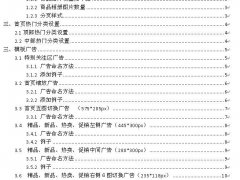默认wordpress归档工具是按照年月展示,如果博客建站时间久了之后归档列表就会拉很长,放哪里都不美观。所以现在是该把文章归档好好整理下。我觉得最简单的办法就是新建一个页面,里面只显示归档文章,包括标题、发表时间和链接等信息。添加的功能最好全自动化,我可不想因为某个功能而去多操作一步。这也是博主的原则和基本要求。 思路有两个,一是直接取wordpress数据库的文章,然后统计。这个办法比较简单,不过如果文章量比较大,可能会造成归档页打开缓慢。另外就是增加或者删除文章时,在数据库新增一个表或者一行记录,把归档文章信息保存到那里。然后前台页面直接读一次数据,不需要遍历wordpress文章表。这个办法就是前台读取速度会比较快,但是增加删除文章时可能会卡下。 1、模板函数添加打开wordpress主题文件夹下的functions.php文件,添加如下代码:
function archives_list_SHe() {
global $wpdb,$month;
$lastpost = $wpdb->get_var("SELECT ID FROM $wpdb->posts WHERE post_date <'" . current_time('mysql') . "' AND post_status='publish' AND post_type='post' AND post_password='' ORDER BY post_date DESC LIMIT 1");
$output = get_option('SHe_archives_'.$lastpost);
if(empty($output)){
$output = '';
$wpdb->query("DELETE FROM $wpdb->options WHERE option_name LIKE 'SHe_archives_%'");
$q = "SELECT DISTINCT YEAR(post_date) AS year, MONTH(post_date) AS month, count(ID) as posts FROM $wpdb->posts p WHERE post_date <'" . current_time('mysql') . "' AND post_status='publish' AND post_type='post' AND post_password='' GROUP BY YEAR(post_date), MONTH(post_date) ORDER BY post_date DESC";
$monthresults = $wpdb->get_results($q);
if ($monthresults) {
foreach ($monthresults as $monthresult) {
$thismonth = zeroise($monthresult->month, 2);
$thisyear = $monthresult->year;
$q = "SELECT ID, post_date, post_title, comment_count FROM $wpdb->posts p WHERE post_date LIKE '$thisyear-$thismonth-%' AND post_date AND post_status='publish' AND post_type='post' AND post_password='' ORDER BY post_date DESC";
$postresults = $wpdb->get_results($q);
if ($postresults) {
$text = sprintf('%s %d', $month[zeroise($monthresult->month,2)], $monthresult->year);
$postcount = count($postresults);
$output .= '<ul class="archives-list"><li><span class="archives-yearmonth">' . $text . ' (' . count($postresults) . ' 篇文章)</span><ul class="archives-monthlisting">' . "\n";
foreach ($postresults as $postresult) {
if ($postresult->post_date != '0000-00-00 00:00:00') {
$url = get_permalink($postresult->ID);
$arc_title = $postresult->post_title;
if ($arc_title)
$text = wptexturize(strip_tags($arc_title));
else
$text = $postresult->ID;
$title_text = 'View this post, "' . wp_specialchars($text, 1) . '"';
$output .= '<li>' . mysql2date('d日', $postresult->post_date) . ': ' . "<a href='$url' title='$title_text' target='_blank'>$text</a>";
$output .= ' (' . $postresult->comment_count . ')';
$output .= '</li>' . "\n";
}
}
}
$output .= '</ul></li></ul>' . "\n";
}
update_option('SHe_archives_'.$lastpost,$output);
}else{
$output = '<div class="errorbox">Sorry, no posts matched your criteria.</div>' . "\n";
}
}
echo $output;
}
添加后保存。这行代码会在你的wp-options表中添加一个类似SHe_archives_xxx的记录。 2、制作页面模板复制一份主题的 page.php 更名为 archives.php,然后在最顶端加入: <?php /* Template Name: archives */ ?> 再找到类似 <?php content(); ?>,在其下面加入如下代码: <div id="archives"><?php archives_list_SHe(); ?></div> 3、新建archive归档页进wordpress后台添加一新页面,在右侧栏模板选择 archives。 到这一步,免插件纯代码实现WordPress文章的归档页面就算完成了。 |
WordPress免插件实现文章归档页的方法
时间:2016-01-17 10:28来源:未知 作者:最模板 点击:次
默认wordpress归档工具是按照年月展示,如果博客建站时间久了之后归档列表就会拉很长,放哪里都不美观。所以现在是该把文章归档好好整理下。我觉得最简单的办法就是新建一个页面
顶一下
(0)
0%
踩一下
(0)
0%
------分隔线----------------------------
- 热点内容
-
- wordpress网站手动裁切图片
我们在很多主题都需要设置一张特色图片作为文章的封面图片,...
- WordPress速度优化详解
我们归纳了一些WordPress速度方面的方法和插件,并详细介绍使用...
- 让您的站点主页与WordPress安装目录
对于刚刚安装WordPress博客的站长来说,会感觉到头疼,为什么会...
- 在Wordpress首页调用多媒体的分类和
1:Wordpress后台获取:自定义分类的ID (默认分类也可获取) 2:...
- 在wordpress中插入虾米音乐
虾米音乐可以在wordpress博客中挂外链音乐,这个功能可以说是非...
- wordpress网站手动裁切图片
- 随机模板
-
-
 ecshop仿聚美模板免费整站
人气:3737
ecshop仿聚美模板免费整站
人气:3737
-
 ecshop仿美乐乐家具商城模
人气:1726
ecshop仿美乐乐家具商城模
人气:1726
-
 ecshop专业汽车用品英文外
人气:1021
ecshop专业汽车用品英文外
人气:1021
-
 lumi化妆品商网店城|ecsho
人气:442
lumi化妆品商网店城|ecsho
人气:442
-
 Logancee多用途外贸服饰鞋包
人气:435
Logancee多用途外贸服饰鞋包
人气:435
-
 ecshop仿凡客免费模板带安
人气:5647
ecshop仿凡客免费模板带安
人气:5647
-
